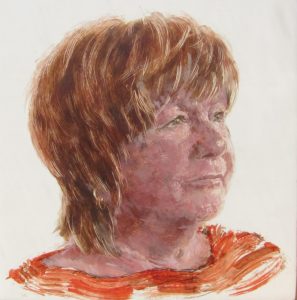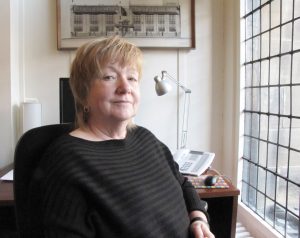
Interview date: 12 July 2010
Location: Director’s Office, Glasgow School of Art, Scotland
Present: Seona Reid, Frances Robertson and Sharon Thomas
We meet in Seona’s office within the Mackintosh Building at the Glasgow School of Art. The Director’s office adjoins the first floor Mackintosh Museum, and sits above the foyer entrance, overlooking the sweep of steps on to Renfrew Street. The office/ meeting space is spaciously set out and furnished with Mackintosh pieces such as chairs/ tableand writing desk. There is a small private cloakroom/ pantry and a studio space above, reached by a narrow spiral staircase, that gives the whole area the hushed secluded character of a retreat or private suite; however, that feeling is so strongly in accord with our perception of the Mackintosh’s architectural vision that it holds the host and visitor suspended in anonymity. By contrast, the choice of paintings by alumni of the School on the walls indicate more an individual mixture of personal choices. I begin by asking about Seona’s relationship with the space and architecture of her working environment? Replying at a tangent, Seona explains that she has begun to develop the notion that Mackintosh used space to focus attention, which she likens to the mysterious pleasures of scrutinizing the world through good binoculars. In essence she appreciates the quiet calm of the room, and the way in which when alone it envelopes and allows one to develop ideas at length. Mackintosh was not purely a visual architect but one whose work had strong tactile and surface qualities; in particular the Glasgow School of Art is in command of the person moving around its interior by the glossy smooth surface of ‘Glasgow marble’, that creates an echoing, cavernous yet cocooning enclosure.

Seona in GSA office Spring, 2010
In respect to the sense of gender of architectural space, I ask about the body of feminist inspired literature and debate within design history about the relationship between Charles Rennie Mackintosh and his wife Margaret Macdonald; with particular focus on the notion that his attention to the minutiae of interiors incorporated a female approach. In response Seona is resistant to what she calls a ‘dangerous gender prism’ of viewing Mackintosh’s work in this way, especially considering the myths that prevail around Mackintosh and his wife such as that Margaret was the Carer who provided stability for a reactive and difficult husband. For Seona, such ideas, originally useful to overturn the notion of the inspired and solitary male genius that previously held sway, now threaten to create a new and rather lazy stereotype. However, Seona is ready to acknowledge that the Art School does need a corrective to a ‘male brooding history’, especially in regard to her own entry as Director, and also her previous entry to the Scottish Arts Council; both experiences that had been ‘brutal’ uncomfortable times requiring direct confrontation with a wall of contempt simply because she was a woman in power. Recalling her work at the SAC, she recalls the ‘Neanderthal’ notion of arts activity and policy with a few mainstream elite companies,
and little attention being paid to community arts, development work with local authorities, or more popular art forms. The antagonism from within the organisation was often manifested by treating her as a minor female creature, for example, introducing her by first name only, whilst introducing male colleagues by full name and title. Moving to GSA as the first woman Director meant that a similar wall of male entrenched resistance came into force all over again; again often manifested as a kind of academic or specialist arrogance, such as ‘talking over’ her speech and ignoring her direction. In an art school today, frequently dominated by female student applications, severe gender imbalances are set in train at both staff and student levels. At student level, the ratio of female to male is 65% to 35%, reflecting a notion in society that art school study is generally non-serious or frivolous, apart from architecture and product design engineering, which certainly suffers no female over-representation, instead attracting a predominantly male student body. At academic staff level, the gender balance is reversed, with only 20% female staff members and 80% male; furthermore many of the female posts are part-time or lower on the hierarchy. This is one area where Seona would like to see a change before the end of her tenure as Director of the Glasgow School of Art.
I ask Seona who does she look up to or rate as a female role model? Writers are the first people that come to her mind such as celebrated authors Toni Morrison or Margaret Atwood. Equally, Seona rates singer Tina Turner highly, for her personal strength and attractiveness alongside a kind of modesty and balance that Seona attributes perhaps to Turner’s well- known Buddhist views. But above all for Seona her top tribute is paid to her first greatly inspiring psychotherapist. Being sensitive to what is clearly a very personal experience I ask Seona if talking about therapy is something she is confident to do. In response Seona is keen to relay the huge support that therapy has been on the occasion in her life when breakdown has affected her life, and the importance of honesty about such experiences. In both cases of treatment primary causes of disruption were caused by over working and refusal to relax and turn off the work button. Seona looks in commendment at successful friends and colleagues that manage to juggle the stresses of a busy life, such as a male friend that was Chair of the Arts Council of England, who strategically rationed his work hours to a 4-day week. This regiment succeeded in achieving intense work output as well as leisure time to relax and cleanse the mind. Seona remarks that this is not an easy task for a professional high-achiever to learn, as all training education and upbringing has up to this point usually been directed in the opposite direction.
Yet commendation is not only given to her psychotherapy treatment and the great lessons that she has learned from this to better manage her life, great credit and tribute is made to the honesty of being a gay woman. For Seona her gender and sexuality have been sturdy posts which have never been in question and have created equilibrium and pride in her life. Moreover this sense of difference has always been a liberating force, offering a way out of the rather constricted and comfortable middle- class Glasgow suburban milieu she grew up in. Indeed studying at University in the late 1960s: forging a new personal and social life away from home was like a ‘door opening’. And it is this honesty and strength that has propelled Seona in the positions that she has directed during her career and ones that Seona promotes to all other women that consider forging a similar path.
Frances Robertson, 2011
Copyright Frances Robertson
